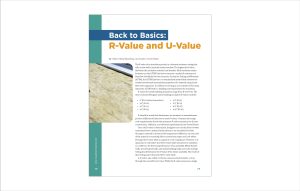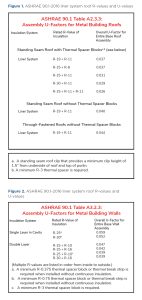Back to Basics: R-Value and U-Value
The R-value of an insulation product is a thermal resistance rating that tells us how well a material resists heat flow. The higher the R-value, the better the insulation restricts heat transfer. Most insulation manufacturers use the ASTM C518 test to measure a material’s resistance to heat flow. Established by the American Society for Testing and Materials (ASTM), the ASTM C518 test is a standardized method that assesses the steady-state thermal transmission properties of a material using a heat flow meter apparatus. In addition to serving as an essential tool for many industries, ASTM C518 is a building code requirement for insulation.
R-values for metal building insulation range from R-8 to R-30. The most common fiberglass metal building insulation R-values include:
- 2” (R-8, before lamination)
- 3.4” (R-10)
- 3.7” (R-11)
- 4.3” (R-13)
- 5.3” (R-13)
- 6.3” (R-19)
- 8.0” (R-25)
- 9.25” (R-30)
It should be noted that thicknesses are nominal, as manufacturers produce different thicknesses to meet R-values. Commercial energy code requirements dictate the minimum R-value necessary for all new construction, additions, and alterations performed in the United States.
Once the R-value is determined, designers can use this data to better understand how a material will perform in an assembly. Heat flow through a material is driven by the temperature difference on each side of the material or assembly. Most construction types and code tables leverage the R-value table as a guide to code compliance. However, it is important to remember that the R-value table should not be mistaken as a reference for the total performance of an assembly. Metal-framed walls, wood-framed walls, and metal building walls and roofs undergo testing that determines the U-value of the entire assembly. The result of that testing can be found in the U-value table.
A U-value, also called a U-factor, measures heat transfer, or loss, through the assembly over time. While the R-value measures a single product’s ability to resist heat, the U-value measures the entire assembly’s resistance to heat transfer. The lower the U-factor, the better the insulation. Mathematically, R-values and U-values are reciprocals of one another: U-value = 1/R-value, R-value = 1/U-value. ASTM C1363 is the standard test method of U-values and includes a hot box apparatus. See Figure 1 and Figure 2.


